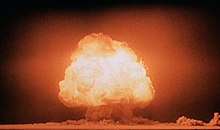User:Danielkueh/sandbox
Subsections[edit]
Evolution[edit]
Recombination allows alleles on the same strand of DNA to become separated. However, the rate of recombination is low (approximately two events per chromosome per generation). As a result, genes close together on a chromosome may not always be shuffled away from each other and genes that are close together tend to be inherited together, a phenomenon known as linkage.[1] This tendency is measured by finding how often two alleles occur together on a single chromosome compared to expectations, which is called their linkage disequilibrium. A set of alleles that is usually inherited in a group is called a haplotype. This can be important when one allele in a particular haplotype is strongly beneficial: natural selection can drive a selective sweep that will also cause the other alleles in the haplotype to become more common in the population; this effect is called genetic hitchhiking or genetic draft.[2] Genetic draft caused by the fact that some neutral genes are genetically linked to others that are under selection can be partially captured by an appropriate effective population size.[3]
Science and warfare[edit]

One area of significant impact of science is its use in the development of weapons of war.
Describe development of gun powder, artillery, and explosives.
Describe development of chemical and biological weapons
Describe development of missiles.
Describe development of atomic bomb
Describe ethical concerns within the scientific community regarding the use of science in weapons development
Animal physiology[edit]
Lead[edit]
Fundamentals[edit]
Food, energy, and temperature[edit]
Integrating systems[edit]
Muscle and movement[edit]
Oxygen, carbon dioxide, and internal transport[edit]
Water, salts, and excretion[edit]
References[edit]
- ^ Lien, Sigbjørn; Szyda, Joanna; Schechinger, Birgit; et al. (February 2000). "Evidence for Heterogeneity in Recombination in the Human Pseudoautosomal Region: High Resolution Analysis by Sperm Typing and Radiation-Hybrid Mapping". American Journal of Human Genetics. 66 (2): 557–566. doi:10.1086/302754. ISSN 0002-9297. PMC 1288109. PMID 10677316.
- ^ Barton, Nicholas H. (November 29, 2000). "Genetic hitchhiking". Philosophical Transactions of the Royal Society B: Biological Sciences. 355 (1403): 1553–1562. doi:10.1098/rstb.2000.0716. ISSN 0962-8436. PMC 1692896. PMID 11127900.
- ^ Cite error: The named reference
gillespie 2001was invoked but never defined (see the help page). - ^ Jungk 1958, p. 201.

